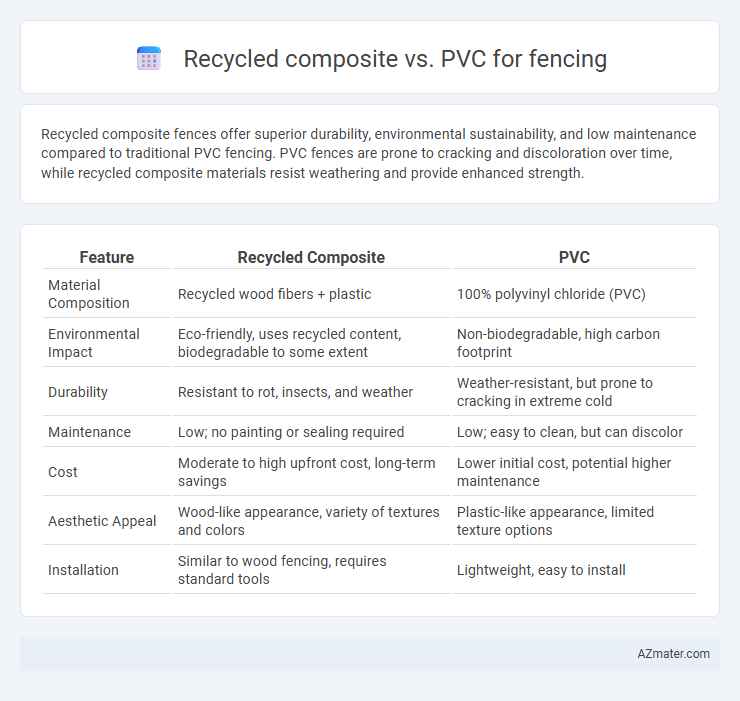Recycled composite fences offer superior durability, environmental sustainability, and low maintenance compared to traditional PVC fencing. PVC fences are prone to cracking and discoloration over time, while recycled composite materials resist weathering and provide enhanced strength.
Table of Comparison
| Feature | Recycled Composite | PVC |
|---|---|---|
| Material Composition | Recycled wood fibers + plastic | 100% polyvinyl chloride (PVC) |
| Environmental Impact | Eco-friendly, uses recycled content, biodegradable to some extent | Non-biodegradable, high carbon footprint |
| Durability | Resistant to rot, insects, and weather | Weather-resistant, but prone to cracking in extreme cold |
| Maintenance | Low; no painting or sealing required | Low; easy to clean, but can discolor |
| Cost | Moderate to high upfront cost, long-term savings | Lower initial cost, potential higher maintenance |
| Aesthetic Appeal | Wood-like appearance, variety of textures and colors | Plastic-like appearance, limited texture options |
| Installation | Similar to wood fencing, requires standard tools | Lightweight, easy to install |
Introduction to Recycled Composite and PVC Fencing
Recycled composite fencing combines reclaimed wood fibers and plastic to create a durable, eco-friendly alternative to traditional materials, offering enhanced resistance to rot and insects. PVC fencing, made from polyvinyl chloride, provides low maintenance, water resistance, and long-lasting durability without the environmental benefits of recycled content. Both materials serve as popular choices for modern fencing, balancing performance with aesthetic appeal.
Material Composition and Environmental Impact
Recycled composite fencing is primarily made from a blend of reclaimed wood fibers and recycled plastics, offering enhanced durability and resistance to rot compared to traditional PVC fences composed of polyvinyl chloride. The manufacturing of recycled composite materials reduces landfill waste and lowers carbon emissions by repurposing industrial byproducts, whereas PVC production involves significant fossil fuel consumption and generates harmful dioxins during manufacturing and disposal. Environmentally, recycled composites present a sustainable alternative with a smaller ecological footprint, combining both reclaimed content and recyclability, while PVC fences contribute to plastic pollution and pose challenges for recycling processes.
Durability and Weather Resistance Comparison
Recycled composite fencing offers superior durability and weather resistance compared to PVC, resisting cracking, warping, and fading even under extreme temperature fluctuations and UV exposure. Unlike PVC, which may become brittle over time and is susceptible to discoloration, recycled composites maintain structural integrity and color retention due to their wood-fiber and plastic blend. This composite material also excels in moisture resistance, minimizing rot and insect damage, ensuring a longer-lasting fence with lower maintenance requirements.
Aesthetic Options and Design Flexibility
Recycled composite fencing offers a wide range of aesthetic options, including various wood grain textures and colors that mimic natural wood while providing enhanced durability against weather and insects. PVC fencing, known for its sleek, clean lines, delivers consistent color and low maintenance but is limited in texture and design variety compared to composites. The design flexibility of recycled composites allows for custom shapes and patterns, making them ideal for diverse landscape styles, whereas PVC fencing usually restricts customization to standard panel sizes and simple forms.
Installation Process and Maintenance Requirements
Recycled composite fencing offers a straightforward installation with interlocking panels and pre-drilled holes, reducing labor time compared to PVC's need for precise cutting and gluing. Maintenance for recycled composite is minimal, requiring only occasional washing to prevent dirt buildup, while PVC fences often demand regular cleaning to avoid staining and may be prone to cracking in extreme temperatures. Both materials resist rot and insect damage, but recycled composites provide greater durability and stability, reducing long-term upkeep costs.
Cost Analysis: Upfront and Long-Term Expenses
Recycled composite fences typically have a higher upfront cost than PVC fences due to the sustainable materials and manufacturing processes involved. Over the long term, recycled composite fences offer better durability and lower maintenance expenses, reducing total cost of ownership compared to PVC, which may require more frequent repairs and replacements. Evaluating lifecycle costs reveals recycled composite as a more cost-effective option despite the initial investment, especially in regions with harsh weather conditions.
Performance in Different Climates
Recycled composite fencing offers superior durability and resistance to moisture, UV exposure, and temperature fluctuations compared to PVC, making it ideal for diverse climates including humid, coastal, and extreme seasonal changes. Unlike PVC, which can become brittle in cold weather and warp under intense heat, recycled composites maintain structural integrity and color stability over time. This performance advantage ensures lower maintenance costs and longer lifespan in varying environmental conditions.
Safety and Toxicity Considerations
Recycled composite fencing offers significant safety advantages over PVC fences due to its non-toxic composition and absence of harmful chemicals such as phthalates and lead, which are often present in PVC materials. Composite materials are less prone to off-gassing volatile organic compounds (VOCs), contributing to healthier outdoor environments. The durability and fire resistance of recycled composite products further enhance safety, making them a preferred choice for residential and commercial fencing applications.
Lifespan and Warranty Insights
Recycled composite fencing typically offers a lifespan of 25-30 years, outperforming traditional PVC fences which last about 15-20 years under similar conditions. Warranty periods for recycled composite fences often extend up to 30 years and cover structural integrity and resistance to rot or insect damage, while PVC fences usually come with warranties ranging from 10 to 15 years primarily against cracking and fading. Choosing recycled composite materials provides enhanced durability and long-term value, supported by more comprehensive warranty protections compared to PVC options.
Which Fence Material is Best for Your Needs?
Recycled composite fencing offers superior durability, low maintenance, and eco-friendly benefits compared to traditional PVC fences, which are lightweight and cost-effective but prone to cracking over time. Composite materials resist fading, rotting, and insect damage, making them ideal for long-term outdoor use, while PVC fences require less initial investment but may need replacement sooner. Choosing between recycled composite and PVC depends on factors like budget, environmental impact, and desired fence longevity tailored to your specific fencing needs.

Infographic: Recycled composite vs PVC for Fence
 azmater.com
azmater.com